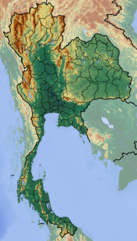Sukhothai historic park
 |
|
| UNESCO World Heritage Site | |
|---|---|
| Location | Mueang Kao, Thailand |
| Coordinates | 17°01′16″N 99°42′13″E / 17.021111111111°N 99.703611111111°E |
| Criteria | i, iii |
| Reference | 574 |
| Inscription | 1991 (15th Session) |
|
[]
|
|
The Sukhothai Historical Park (Thai: อุทยานประวัติศาสตร์สุโขทัย (Pronunciation)) covers the ruins of Sukhothai, literally "Dawn of Happiness", capital of the Sukhothai Kingdom in the 13th and 14th centuries, in what is now Northern Thailand. It is located near the modern city of Sukhothai, capital of the province with the same name.
The city walls form a rectangle about 2 km east-west by 1.6 km north-south. There are 193 ruins on 70 square kilometers of land. There is a gate in the centre of each wall. Inside are the remains of the royal palace and twenty-six temples, the largest being Wat Mahathat. The park is maintained by the Fine Arts Department of Thailand with help from UNESCO, which has declared it a World Heritage Site. Each year, the park welcomes thousands of visitors who marvel at the ancient Buddha figures, palace buildings and ruined temples. The park is easily toured by bicycle or even on foot.
Prior to the 13th century, a succession of Tai kingdoms existed on the northern highlands including the Ngoenyang (centered on Chiang Saen; predecessor of Lan Na) kingdom and the Heokam (centered on Chiang Hung, modern Jinghong in China) kingdom of Tai Lue people. Sukhothai had been a trade center and part of Lawo, which was under the domination of the Khmer Empire. The migration of Tai people into the upper Chao Phraya valley was somewhat gradual.
...
Wikipedia

